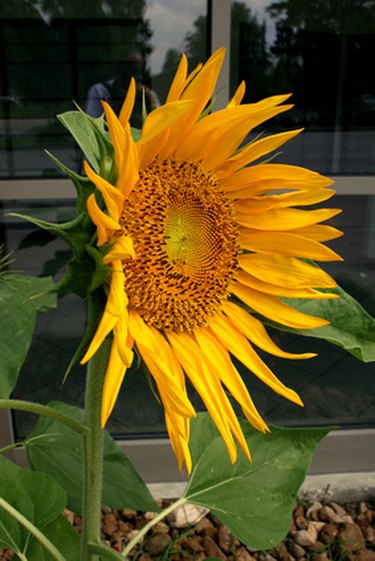
Every part of the sunflower has a use for something, and no part goes to waste. Native Americans have used the sunflower plants for centuries. They are native to the United States and they rank as one of the four major crops of global importance. One of the unique aspects about sunflowers is that their heads follow the movement of the sun.
Food Source
Video of the Day
Raw sunflower kernels are nutritious for humans. The kernels contain 55 percent protein. Other vitamins and minerals in sunflowers include B, E and A vitamins, phosphorus, nitrogen, calcium and iron. If you remove the flowers when they are just buds, they can be cooked and eaten like artichokes. Sunflowers also provide a source of food for birds and animals. They retain their flower heads filled with seeds so during the cold winter months, animals can find food. Sunflowers are a staple ingredient in the majority of commercial birdseed and the leaves are often used to make feed for livestock.
Video of the Day
Oil
One acre of sunflowers can provide more oil than 1 acre of soybeans. An acre of sunflowers is able to produce 600 pounds of oil that can be used for cooking. Sunflower oil is also used to make soap, lubricants and candles. The oil is also used to treat skin conditions, sinusitis, hemorrhoids and leg ulcers
Cleaning Contaminated Water
Sunflower roots helped clean contaminated water in Chernobyl. According to Botany Global Issues, sunflowers were grown on floating pieces of styrofoam and placed over the contaminated water. The sunflower’s roots removed 95 percent of the radioactivity in 24 hours.
Medicinal Uses
The roots of the sunflower plant, when made into a poultice, can be used for snakebites and spider bites. The leaves can brewed into a tea and ingested to treat fevers, lung ailments and diarrhea.
Other Uses
It seems like there is no end to the sunflower's uses. People use the flowers to make a dye. The stems are used to make a number of things like paper, clothes and microscope slide mounts. Years ago, people used pieces of the stems to fill life preservers and many people burned them when firewood was scarce.